| THROUGH THE YEARS,
freight equipment dominated the Conway Electric's roster of rolling stock. At its peak, the line's motorized equipment included two combination passenger-baggage cars, one open and one closed passenger car, a snow plow, a line car for maintenance, and a freight motor for hauling freight cars and carrying baggage. It also had an open passenger trailer and an assortment of 18 small freight trailers ranging in overall length from 15' to 19'. The line's steep grades and sharp turns prohibited the use of standard-size freight equipment. Even the combination cars were small by most standards, one measuring 33' overall, the other 32'. All cars except the combination cars were of the single truck (i.e., 4-wheel) variety.
After the B&M Railroad gained control of the Conway Electric in 1908, the former built a number of freight cars and the freight motor in its own shops for the line. B&M also provided a new, second combination car built by Wason.
It is assumed that, except where noted, all equipment survived till the end of operations.
ROSTER from the early years (1895-1908)
Combination car:
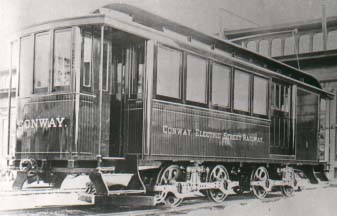 #1 - was 32' long, built by the Wason Manufacturing Co. of Springfield, MA in 1895. This car, along with combination car #2, which joined the line in 1912, was the workhorse of the line and could be counted on to haul an occasional freight car when required. #1 - was 32' long, built by the Wason Manufacturing Co. of Springfield, MA in 1895. This car, along with combination car #2, which joined the line in 1912, was the workhorse of the line and could be counted on to haul an occasional freight car when required.
-
Passenger cars:
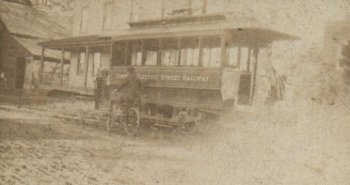 #4 - a closed car built by the Jones Car Co. Little is known of this car except that an early photograph shows a small 4-wheel passenger car bearing the number 20. It is generally assumed that the two are the same. #4 - a closed car built by the Jones Car Co. Little is known of this car except that an early photograph shows a small 4-wheel passenger car bearing the number 20. It is generally assumed that the two are the same.
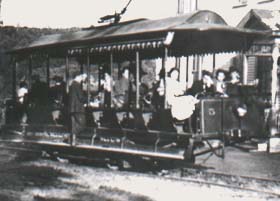 #5 - a 9-bench, 27'-long open car built by Jones. It was purchased second-hand, having originally been a horse-drawn car. #5 - a 9-bench, 27'-long open car built by Jones. It was purchased second-hand, having originally been a horse-drawn car.
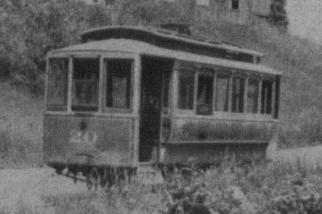 #20 - Found at last: the elusive #20. This picture was cropped from a photo taken in front of but facing away from the Masonic Lodge. Is this the former #4 with closed in vestibules? Most likely. (Photo from Alice Eldridge collection.) #20 - Found at last: the elusive #20. This picture was cropped from a photo taken in front of but facing away from the Masonic Lodge. Is this the former #4 with closed in vestibules? Most likely. (Photo from Alice Eldridge collection.)
Passenger trailer:
#2 - an open trailer, retired around 1911. Little is known of this car. -
Freight/service cars:
#3 - a tower car provided a platform from which the overhead trolley wire could be maintained. Little is known of this car, except that it was retired in 1915. Later, a 14'-long flat car carried the number 14. (Information is not clear as to whether flat car #14 replaced or coexisted with box car #14 listed below.)
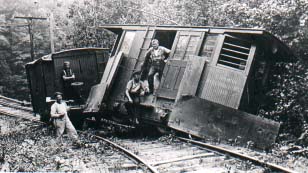 #30 - a 24'-long snow plow built by Wason in 1895. When not plowing snow, it was used to haul freight cars until freight motor #11 arrived in 1910. #30 - a 24'-long snow plow built by Wason in 1895. When not plowing snow, it was used to haul freight cars until freight motor #11 arrived in 1910. -
Freight trailers:
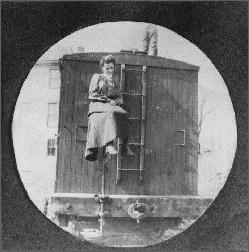 #12-#15 - were 15'-long box cars built by Wason. (Photo from Alice Eldridge collection.) #12-#15 - were 15'-long box cars built by Wason. (Photo from Alice Eldridge collection.)
#16-#18 - were 16'-long coal cars built by Wason.
#19 - a 19'-long flat car built by Wason.
#20 - an 18'-long flat car built by Wason.
-
ROSTER additions during the B&M years (1908-1919)
Combination car:
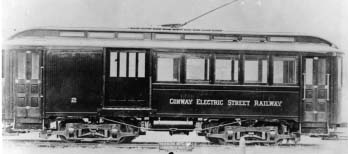 #2 - was 33' long, built by Wason in 1912. It was the only car on the line equipped with air brakes. #2 - was 33' long, built by Wason in 1912. It was the only car on the line equipped with air brakes.
-
Freight motor:
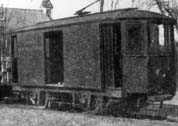 #11 - was 25' long, built by B&M in 1910. This car was used to haul freight cars and carry baggage. #11 - was 25' long, built by B&M in 1910. This car was used to haul freight cars and carry baggage.
-
Freight trailers:
#21-#28 - were 19'-long flat cars built by B&M in 1911. -
ROSTER final years (1919-1921)
No further changes have been recorded.
Alfred Barten, 31 January 2001.
|
 #1 - was 32' long, built by the Wason Manufacturing Co. of Springfield, MA in 1895. This car, along with combination car #2, which joined the line in 1912, was the workhorse of the line and could be counted on to haul an occasional freight car when required.
#1 - was 32' long, built by the Wason Manufacturing Co. of Springfield, MA in 1895. This car, along with combination car #2, which joined the line in 1912, was the workhorse of the line and could be counted on to haul an occasional freight car when required. #4 - a closed car built by the Jones Car Co. Little is known of this car except that an early photograph shows a small 4-wheel passenger car bearing the number 20. It is generally assumed that the two are the same.
#4 - a closed car built by the Jones Car Co. Little is known of this car except that an early photograph shows a small 4-wheel passenger car bearing the number 20. It is generally assumed that the two are the same. #5 - a 9-bench, 27'-long open car built by Jones. It was purchased second-hand, having originally been a horse-drawn car.
#5 - a 9-bench, 27'-long open car built by Jones. It was purchased second-hand, having originally been a horse-drawn car. #20 - Found at last: the elusive #20. This picture was cropped from a photo taken in front of but facing away from the Masonic Lodge. Is this the former #4 with closed in vestibules? Most likely. (Photo from Alice Eldridge collection.)
#20 - Found at last: the elusive #20. This picture was cropped from a photo taken in front of but facing away from the Masonic Lodge. Is this the former #4 with closed in vestibules? Most likely. (Photo from Alice Eldridge collection.) #30 - a 24'-long snow plow built by Wason in 1895. When not plowing snow, it was used to haul freight cars until freight motor #11 arrived in 1910.
#30 - a 24'-long snow plow built by Wason in 1895. When not plowing snow, it was used to haul freight cars until freight motor #11 arrived in 1910. #12-#15 - were 15'-long box cars built by Wason. (Photo from Alice Eldridge collection.)
#12-#15 - were 15'-long box cars built by Wason. (Photo from Alice Eldridge collection.)
 #2 - was 33' long, built by Wason in 1912. It was the only car on the line equipped with air brakes.
#2 - was 33' long, built by Wason in 1912. It was the only car on the line equipped with air brakes.  #11 - was 25' long, built by B&M in 1910. This car was used to haul freight cars and carry baggage.
#11 - was 25' long, built by B&M in 1910. This car was used to haul freight cars and carry baggage.